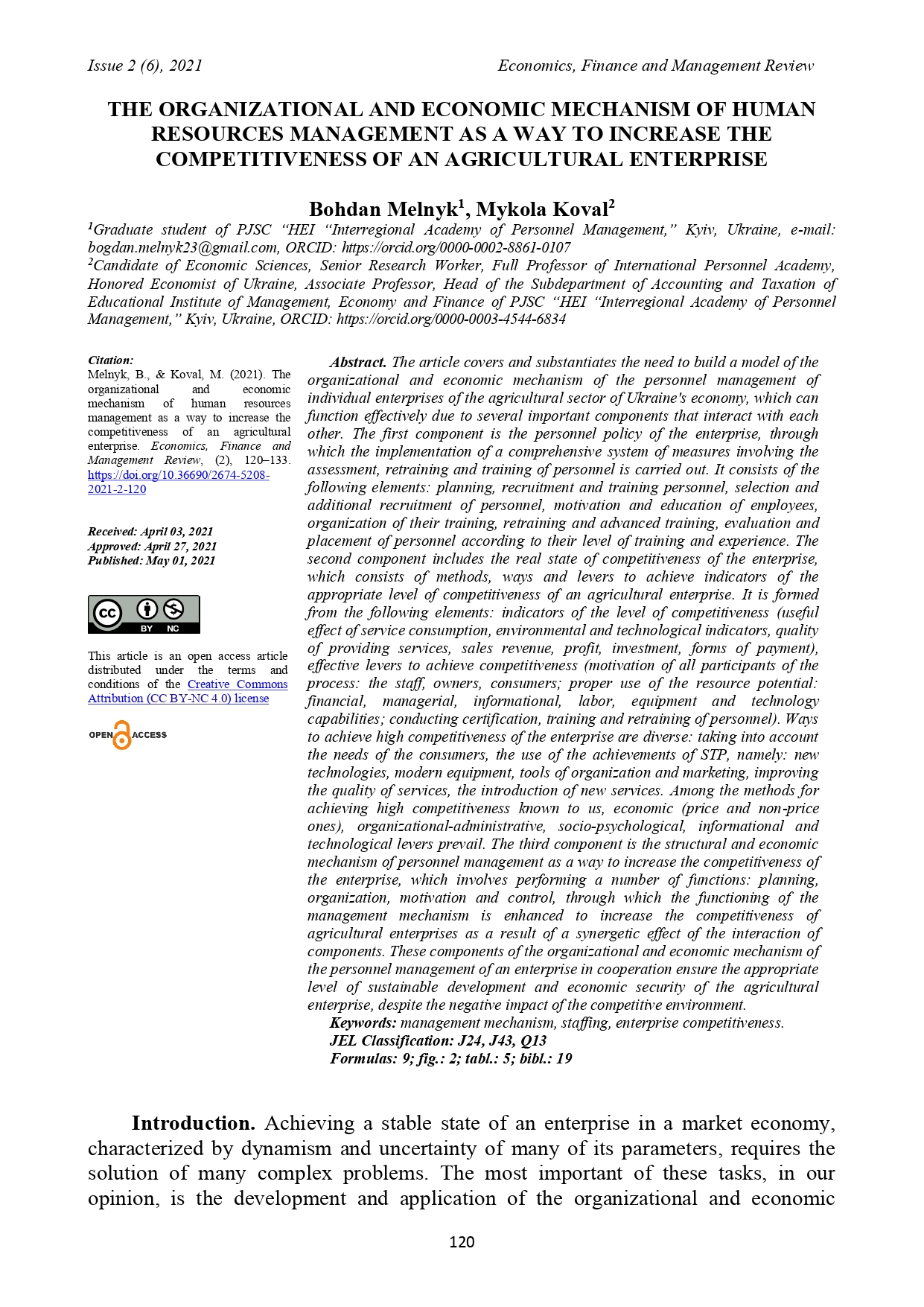THE ORGANIZATIONAL AND ECONOMIC MECHANISM OF HUMAN RESOURCES MANAGEMENT AS A WAY TO INCREASE THE COMPETITIVENESS OF AN AGRICULTURAL ENTERPRISE
DOI:
https://doi.org/10.36690/2674-5208-2021-2-120Keywords:
management mechanism, staffing, enterprise competitivenessAbstract
The article covers and substantiates the need to build a model of the organizational and economic mechanism of the personnel management of individual enterprises of the agricultural sector of Ukraine's economy, which can function effectively due to several important components that interact with each other. The first component is the personnel policy of the enterprise, through which the implementation of a comprehensive system of measures involving the assessment, retraining and training of personnel is carried out. It consists of the following elements: planning, recruitment and training personnel, selection and additional recruitment of personnel, motivation and education of employees, organization of their training, retraining and advanced training, evaluation and placement of personnel according to their level of training and experience. The second component includes the real state of competitiveness of the enterprise, which consists of methods, ways and levers to achieve indicators of the appropriate level of competitiveness of an agricultural enterprise. It is formed from the following elements: indicators of the level of competitiveness (useful effect of service consumption, environmental and technological indicators, quality of providing services, sales revenue, profit, investment, forms of payment), effective levers to achieve competitiveness (motivation of all participants of the process: the staff, owners, consumers; proper use of the resource potential: financial, managerial, informational, labor, equipment and technology capabilities; conducting certification, training and retraining of personnel). Ways to achieve high competitiveness of the enterprise are diverse: taking into account the needs of the consumers, the use of the achievements of STP, namely: new technologies, modern equipment, tools of organization and marketing, improving the quality of services, the introduction of new services. Among the methods for achieving high competitiveness known to us, economic (price and non-price ones), organizational-administrative, socio-psychological, informational and technological levers prevail. The third component is the structural and economic mechanism of personnel management as a way to increase the competitiveness of the enterprise, which involves performing a number of functions: planning, organization, motivation and control, through which the functioning of the management mechanism is enhanced to increase the competitiveness of agricultural enterprises as a result of a synergetic effect of the interaction of components. These components of the organizational and economic mechanism of the personnel management of an enterprise in cooperation ensure the appropriate level of sustainable development and economic security of the agricultural enterprise, despite the negative impact of the competitive environment.
Downloads
References
Gerasimova S.V. (2006), №12, Methodical and personnel support of investment activity management of joint-stock companies ..
Golovkova L.S. (2008), № 5, The essence and objectives of human resource management.
Danilenko O.A. (2010), № 8, Features of diagnostics of the personnel management system at the stages of the life cycle of the organization in a competitive environment.
Danilyuk A.I. (2007), № 3, Problems of evaluating the effectiveness of the personnel management system.
Goncharova L.A., Volskaya OM, Bukiashvili VO (2006), The essence of the mechanism of staffing the economy and its place in the economic system of society. retrived from: http://donnasa.org/ publish_house / journals / esgh / 2006 / 06_goncharova_volskaya_ bukiaschvili.pdf
Dolga G.V. Personnel quality assurance of the enterprise management system. Priazovsky Economic Bulletin. 2018. №3. P.48-53.
Change management in terms of innovative development. Qty. Monograph / I.L. Petrova, G.V. Makarkin, I.V. Theron and others. For science. ed. prof. Petrova IL - K .: University "University of Economics and Law" KROK ", 2012. - 268 p. - P. 6-27.
Arthur, W., Jr., Day, E. A., McNelly, T. L., & Edens, P. S. (2003). № 56, A meta-analysis of the criterion-related validity of assessment center dimensions.
Robert E. Ployhart. (2011), Staffing in the 21st Century: New Challenges and Strategic Opportunities.
Williamson, I. O., Lepak, D. P., & King, J. (2003), №63, The effect of company recruitment Web site orientation on individuals ’perceptions of organizational attractiveness.
Ployhart, R. E., & Schneider, B. (2002), № 23, Research in personnel and human resource management.
Gamage, A.S. (2014), №1 "Recruitment and selection practices in manufacturing SMEs in Japan: An analysis of the link with business performance".
Phillips, J.J. and Phillips, P.P. (2012), Proving the Value of HR: How and Why to Measure ROI.
Sutanto, E.M. and Kurniawan, M. (2016), № 17, “The impact of recruitment, employee retention and labor relations to employee performance on batik industry in solo city, Indonesia”.
Rau, B.L. and Adams, G.A. (2013), The Oxford Handbook of Recruitment.
Aoki Masahiko. (1995), A firm in the Japanese economy.
Fedorenko V.G. (2004), № 2, Establishment of industrial and financial groups and problems of corporate rights management.
Saati T. (1991) Analytical planning. Organization of systems.
Papazova E.N. (2006), Analysis of the use of expert systems to assess the potential of organizations.

Downloads
Published
How to Cite
Issue
Section
License

This work is licensed under a Creative Commons Attribution-NonCommercial 4.0 International License.








